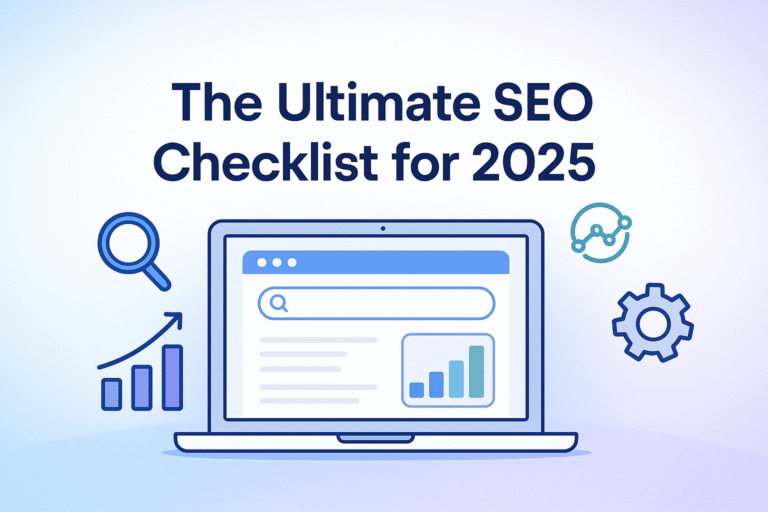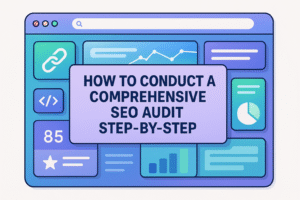Introduction to SEO in 2025
Search Engine Optimization (SEO) is an ever-evolving field that plays a critical role in how businesses connect with their audience online. As we move into 2025, the landscape of SEO continues to change in response to advancements in technology, shifts in user behavior, and updates to search engine algorithms. In today’s digital marketplace, it is essential for businesses to prioritize SEO strategies that reflect these changes to maintain their visibility and improve rankings in search results.
One of the primary reasons for the dynamic nature of SEO is the continual development of search algorithms. Major search engines, particularly Google, consistently refine their algorithms to provide users with the most relevant and high-quality content. This means that businesses must remain vigilant and adaptable, embracing modern techniques and practices that align with these algorithmic updates. This ongoing adaptation is not merely a recommendation; it is a necessity for achieving and sustaining high search rankings.
Moreover, as consumer expectations evolve, so too must the strategies employed by businesses. Users are increasingly demanding exceptional, user-friendly experiences when they navigate the digital space. Factors such as site speed, mobile-friendliness, and content relevance now weigh heavily in determining search rankings. Businesses that ignore these aspects risk losing their competitive edge, as search engines reward those who prioritize the user experience and deliver valuable content.
In this context, the importance of staying informed about modern SEO strategies cannot be overstated. As we delve into the comprehensive checklist that follows, it is crucial to recognize that adapting to changes in SEO is not merely a trend; it is a fundamental requirement for any business seeking to thrive in an increasingly digital world.
Understanding the Importance of an SEO Checklist
In the rapidly evolving digital landscape of 2025, having a structured SEO checklist is paramount for businesses aiming to enhance their online presence. An SEO checklist serves multiple functions, most importantly as a roadmap that aligns a company’s strategies with current best practices and industry standards. With the increasing complexity of search engine algorithms and user expectations, organizations must ensure their SEO efforts are consistent and methodical.
One of the main benefits of employing an SEO checklist is improved organization. By systematically addressing key components such as keyword research, on-page optimization, and backlink strategies, businesses can streamline their workflows and reduce errors that often arise from overlooking essential details. A checklist provides a guided approach, ensuring that all necessary actions are taken to optimize a website effectively, which can lead to higher visibility in search engine results.
Moreover, following a checklist fosters consistency in SEO efforts. Consistent implementation of SEO strategies is vital, as search engines reward websites that adhere to established guidelines over time. An organized checklist allows teams to align their goals and maintain uniformity, even when multiple team members are involved in different aspects of the SEO process. This collective effort can significantly enhance a brand’s overall SEO performance.
Another critical advantage of utilizing an SEO checklist lies in the ability to measure progress. By documenting completed tasks and results, businesses can track the effectiveness of their strategies and make data-driven decisions. This ongoing evaluation not only provides insight into what is working but also highlights areas for improvement, allowing companies to refine their approach continually in a competitive landscape. Thus, an SEO checklist becomes an indispensable tool for businesses striving to achieve long-term success in their online visibility.
On-Page SEO Best Practices
On-page SEO is an essential aspect of search engine optimization that focuses on elements within a website or webpage. As we move into 2025, businesses must scrutinize various components to ensure enhanced visibility in search engine results and improved user experience. One critical factor is keyword optimization. This involves strategically placing relevant keywords within the content to signal to search engines the primary topics of a page. However, businesses must ensure to maintain a natural flow in the content, avoiding keyword stuffing, which can harm readability and user retention.
Another important on-page element is meta tags, particularly the title and description tags. These tags provide brief summaries of the content to search engines and users. In 2025, utilizing compelling and descriptive meta tags will become increasingly significant as users often make click decisions based on these snippets. Therefore, ensuring that these tags contain targeted keywords can enhance organic search rankings and click-through rates.
Header structure also plays a vital role in organizing content for both search engines and users. A well-structured header system, including H1, H2, and H3 tags, helps to guide readers through the material, making it easier for them to find relevant information quickly. It is advisable to incorporate keywords in headers as well, as search engines use them to understand the hierarchy and relevance of the content.
Content quality remains paramount in the on-page SEO landscape. Content that is informative, relevant, and engaging not only enhances user satisfaction but also encourages users to spend more time on a website, which positively impacts ranking algorithms. Metrics related to user engagement, such as bounce rate and dwell time, are increasingly being factored into SEO strategies. Websites that effectively meet user needs and expectations are more likely to succeed in achieving high search rankings.
Technical SEO Essentials
In 2025, mastering technical SEO remains crucial for enhancing search engine visibility and improving overall website performance. One primary focus is on site speed optimization, as Google has increasingly emphasized the significance of fast-loading pages. Tools such as Google PageSpeed Insights, GTmetrix, and lighthouse can provide valuable insights into site speed, helping webmasters identify areas for improvement.
Another essential component of technical SEO is mobile-first indexing. With a growing number of users accessing websites through mobile devices, it is imperative that sites are optimized for mobile. Ensuring responsive design, user-friendly navigation, and faster load times on mobile can boost rankings significantly. Regular testing across various devices helps maintain an optimal experience for all users.
Crawlability is a critical aspect that often goes overlooked. Search engine crawlers need to access and index website content efficiently. Conducting periodic audits using tools such as Screaming Frog or SEMrush can identify crawling issues, such as broken links and duplicate content, which may hinder search engine performance. Implementing effective XML sitemaps and leveraging robots.txt files can assist in managing crawler access efficiently.
Schema markup plays a fundamental role in helping search engines understand content context more effectively, enhancing search visibility in rich snippets. By incorporating structured data into your website, you can provide search engines with valuable information that may boost click-through rates. Utilizing Google’s Structured Data Markup Helper can simplify this process significantly.
Finally, understanding the role of Core Web Vitals is essential in improving user experience and performance metrics. Focused on metrics such as Largest Contentful Paint (LCP), First Input Delay (FID), and Cumulative Layout Shift (CLS), these indicators help identify potential user experience issues. Tools like Google’s Web Vitals report can help track and enhance these metrics, leading to a more optimized website.
Off-Page SEO Strategies
Off-page SEO plays a crucial role in enhancing a website’s authority and overall rankings in search engine results. Various strategies can be implemented to improve off-page SEO, primarily focused on link building, social media engagement, and collaborative content marketing efforts. One of the fundamental components of off-page SEO is developing a natural backlink profile. Backlinks serve as endorsements from other websites, signaling to search engines that your content is credible and relevant. It is essential to focus on acquiring high-quality links from authoritative and pertinent sources rather than quantity.
One effective strategy for link building is guest blogging. By contributing valuable content to other reputable blogs within your industry, you not only establish backlinks but also position yourself as a trusted expert. Furthermore, engaging actively on social media platforms is another vital aspect of off-page SEO. Sharing valuable content, interacting with followers, and participating in industry discussions can significantly enhance brand visibility and drive traffic to your website. The more engagement your content garners on social media, the higher the likelihood of attracting backlinks from other content creators eager to reference valuable resources.
Another avenue to explore for optimizing off-page SEO is through strategic content marketing collaborations. Partnering with influencers, industry leaders, or complementary businesses allows you to tap into their audience, expanding your reach. This may include co-hosting webinars, producing joint research studies, or creating shared content that appeals to both audiences. Overall, maintaining a positive online reputation is essential. Responding to reviews, addressing negative feedback promptly, and managing your online presence contributes to building trust and authority in the eyes of both users and search engines. By incorporating these strategies into your off-page SEO efforts, you can significantly enhance your website’s visibility and drive increased traffic from external sources.
AI-Powered Content Optimization
In 2025, artificial intelligence (AI) is set to revolutionize the landscape of content creation and optimization. The integration of AI technologies allows businesses to generate high-quality, relevant content that aligns closely with search intent. As search engines become more sophisticated, understanding user intent has never been more crucial. AI-driven tools can analyze massive datasets, enabling businesses to pinpoint trending topics and tailor content accordingly, ensuring that it stays relevant and engaging.
One of the key advantages of AI in content optimization is its ability to assist in keyword research. Tools powered by machine learning can uncover keyword opportunities that were previously overlooked, providing insights into search volumes, competition levels, and related terms. This allows content creators to develop a comprehensive strategy that effectively incorporates a variety of keywords and phrases into their writing, enhancing overall search visibility. Utilizing these tools not only streamlines the research process but also improves the chances of ranking higher in search results.
Another important aspect is content freshness, which remains a significant ranking factor. AI can analyze update patterns, suggesting when and how often content should be refreshed to maintain its relevance. Regularly updating existing content and creating new articles based on AI analysis ensures that businesses are providing up-to-date information that meets the evolving needs of their audience. Additionally, AI can assist in content distribution strategies, identifying the best channels and timing for sharing content to reach target audiences most effectively.
As we move further into 2025, leveraging AI in content optimization will be essential for businesses looking to maintain a competitive edge. By adopting AI tools, companies can enhance their content strategies to produce material that not only meets the requirements of search engines but also resonates with users, ultimately driving traffic and engagement.
Navigating Technical Issues: Common Pitfalls
Technical SEO is a critical component of any comprehensive optimization strategy, as it directly influences how search engines crawl, index, and rank a website. However, several common pitfalls can significantly hinder a website’s performance, resulting in missed opportunities for visibility and traffic. One of the most prevalent issues is indexing problems. Websites may inadvertently block search engines from crawling important pages through misconfigured settings in the robots.txt file or by using noindex tags improperly. Regular audits and use of tools like Google Search Console can help identify these issues quickly, allowing for timely rectifications.
Another common concern is duplicate content. When identical or very similar content appears on multiple URLs, search engines may struggle to determine which page should be prioritized in search results. This can dilute the ranking potential of the affected pages. To resolve this, website owners should implement canonical tags to signal to search engines which version of the content is the primary one. Additionally, conducting routine content audits and using tools to identify duplicate content can aid in maintaining a clean site structure, which is essential for strong SEO performance.
The configuration of the sitemap.xml is equally important. An outdated or incomplete sitemap may lead to important pages being overlooked by search engines. It is advisable to ensure that the sitemap is up-to-date and reflective of the current site structure. Similarly, understanding the nuances of the robots.txt file is crucial; mistakenly blocking sections of the site that should be accessible can lead to significant indexing issues. By addressing these common pitfalls meticulously, businesses can enhance their site health, facilitating optimal indexing and improving overall SEO success.
Utilizing SEO Tools for 2025
As the landscape of digital marketing continues to evolve, the role of Search Engine Optimization (SEO) tools becomes increasingly vital for businesses aiming to enhance their online visibility. In 2025, leveraging the right SEO tools can provide significant advantages, including improved keyword research, performance monitoring, technical audits, and competitive analysis. These tools not only streamline the optimization process but also facilitate informed decision-making based on data insights.
When selecting SEO tools, it is crucial to identify those that align with your specific business needs. For keyword research, consider platforms like Ahrefs, SEMrush, or Google Keyword Planner, which aid in uncovering high-performing keywords relevant to your niche. These tools offer features such as search volume analysis, keyword difficulty assessment, and competitive keyword tracking, serving as critical resources for informed content strategy development.
Performance monitoring tools such as Google Analytics and Moz provide invaluable insights into website traffic and user behavior. These tools allow businesses to track vital metrics such as organic search traffic, bounce rates, and conversion rates, enabling organizations to assess the effectiveness of their SEO efforts continuously. Additionally, utilizing technical audit tools like Screaming Frog or Sitebulb can help identify on-page issues such as broken links, duplicate content, and page speed, which are essential for maintaining a healthy website.
Moreover, competitive analysis tools like SpyFu and SimilarWeb enable businesses to understand their competition better. These platforms offer insights into competitor strategies, including their top-performing keywords and backlinks, equipping businesses with data to refine their own SEO strategies. By utilizing these tools systematically, companies can ensure that their SEO strategies are not only effective but also adaptable to the ever-changing digital environment of 2025.
Conclusion and Future of SEO
As we reflect on the essential strategies outlined in this SEO checklist for 2025, it becomes clear that the field of search engine optimization is not static. The insights we have discussed, ranging from keyword research to content optimization, all underline the importance of a proactive approach to enhancing online visibility. Optimizing for search engines requires a comprehensive understanding of evolving algorithms, user intent, and the competitive landscape.
In 2025 and beyond, businesses must remain agile, consistently updating their SEO strategies to align with emerging trends. This involves keeping abreast of new technologies and consumer behavior changes which can significantly affect search patterns. For instance, the continued rise of voice search and mobile optimization necessitates that brands evaluate their approaches to content delivery and accessibility. SEO is increasingly intertwined with user experience, and websites that prioritize fast loading times and intuitive navigation can reap significant rewards in search rankings.
Furthermore, the integration of artificial intelligence and machine learning into SEO practices is not merely a trend but a transformative shift. These advanced technologies can offer valuable insights into user preferences, thus allowing businesses to tailor their content more effectively. Embracing these advancements will enable organizations to stay relevant in an ever-competitive digital landscape.
Ultimately, maintaining a competitive edge in search visibility relies upon a commitment to continuous learning and adaptation. Regular audits of SEO practices, staying informed about industry updates, and refining strategies based on analytics will help organizations navigate the ever-shifting SEO terrain. As we move forward, it is evident that a dynamic and informed approach to SEO will be crucial for success in the digital marketplace.




